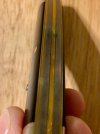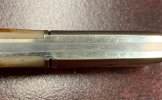JohnDF
Gold Member
- Joined
- May 14, 2018
- Messages
- 28,337
I figured if life gives you lemons, make something to cut them up with


I figured if life gives you lemons, make something to cut them up with


Maybe too much work for what essentially look like cheap advertising knives but whatever, the kids like them.
View attachment 1193235
View attachment 1193240
View attachment 1193236
View attachment 1193237
View attachment 1193238
View attachment 1193239
I was going to give making a folder from scratch a shot again but I ordered some 1095 that was too thick by accident. I figured if life gives you lemons, make something to cut them up with, so I decided to give fixed blades a shot. ThanksRose and Thistle Custom for the wood for the handle.
View attachment 1198296
View attachment 1198297
View attachment 1198294
View attachment 1198295
View attachment 1198298
Edit: I know it’s not a modified production knife, I forget sometimes and just post everything here.

Great.... many thanks for this. I was working with an old, semi beat up Kutmaster that had a slight curvature to it before disassembly. I did hammer the liners a little to try to flatten them, perhaps I didn't carry it far enough. I also sanded everything down, without reducing the thickness to any degree... just tried to sort of level off the high spots. I'm ok with how my first attempt turned out, but I'd like to learn how to do it "better".... that continuous improvement kind of thing...hornetguy I don’t consider myself an expert by any stretch and if anyone else has any other ways of doing it or suggestions I’d like to hear them as well. I think having gaps depends on a few things but the biggest is probably what knife you start with, if it has gaps I think there’s almost a hundred percent chance the finished product will as well, especially if it’s due to pin placement or something. What I do to minimize the gaps is to take it apart as carefully as possible, this way I’m hopefully not introducing any gaps. Once it’s apart I flatten them out if there is a need to and then rough sand to get rid of any high spots or burrs. I then spend a lot of time placing the liners together looking for any bends or where they might separate from each other and looking at general flatness and I use pliers to bend and shape them flat, this is probably the most important part because after this it’s very difficult to make any major changes, I spend days doing this placing them together looking for light passing in between and bending as needed. I then glue and pin the covers on and give them their general shape. Then after the covers are glued and pinned on the liners should be pretty flat but the pins need to be sanded down where the liners were peined on. This is the last part with the liners and I make sure to have a very flat surface to sand them on and I hand sand them varying the directions and orientation to make sure they’re not being sanded more on one side or anything again placing the liners together often to make sure everything is level. After this is done I give the spring a quick light sanding just to remove any burrs or anything there. They then fit together as well as they are going to, but I generally don’t expect perfection, I’ve had many GECs that are better but I’ve also had many that are worse. Hope this helps a little, it’s difficult to describe a physical process in words. I’ll try to post some pictures but I don’t think I’m working on anything now.
Great.... many thanks for this. I was working with an old, semi beat up Kutmaster that had a slight curvature to it before disassembly. I did hammer the liners a little to try to flatten them, perhaps I didn't carry it far enough. I also sanded everything down, without reducing the thickness to any degree... just tried to sort of level off the high spots. I'm ok with how my first attempt turned out, but I'd like to learn how to do it "better".... that continuous improvement kind of thing...

I may not understand exactly what you’re saying, but if you delete one of the blades, the middle liner with the kink in it will be eliminated as well.I have another one that I bought with the intention of removing a blade, and when I got it, I found the center liner to have a distinct "kink" in it. It's enough that when the main blade is open, it looks like it might not be able to close because of the center liner. I'll take pics this evening.
I didn't remember to take any "before" pics of the Kutmaster. I'll try to get "after" pics of it, as well, to show the gaps.
Yes, that is the plan. I was just surprised how "kinky" it was. I'm beginning to wonder if the liners and springs might not be bent, which kinked the middle liner....I cannot imagine anything else that would kink it this badly.I may not understand exactly what you’re saying, but if you delete one of the blades, the middle liner with the kink in it will be eliminated as well.



Not the greatest pic quality, but here is my first attempt at a rebuild. I'm still doing a little tweaking to the kick, to lower the blade tip a bit, smooth up the bolsters a bit, and will likely put another coat of oil on the scales, but this is it... formerly a two blade Kutmaster barlow with delrin scales.





Looks pretty good to me, I think the only way someone can reasonably expect no gaps is if it is a straight recover on a knife that didn’t have gaps to begin with. Once you start changing blades around or making other changes it becomes much less likely that everything will fit together correctly. They are essentially hand made after all, with each one being slightly different than the next. And if you look closely enough even the best ones come with gaps from the factory, my suggestion is to look closely enough to get it as good as it will get and then stop looking.Not the greatest pic quality, but here is my first attempt at a rebuild. I'm still doing a little tweaking to the kick, to lower the blade tip a bit, smooth up the bolsters a bit, and will likely put another coat of oil on the scales, but this is it... formerly a two blade Kutmaster barlow with delrin scales.




And if you look closely enough even the best ones come with gaps from the factory, my suggestion is to look closely enough to get it as good as it will get and then stop looking.
I like the way you think....Looks pretty good to me, I think the only way someone can reasonably expect no gaps is if it is a straight recover on a knife that didn’t have gaps to begin with. Once you start changing blades around or making other changes it becomes much less likely that everything will fit together correctly. They are essentially hand made after all, with each one being slightly different than the next. And if you look closely enough even the best ones come with gaps from the factory, my suggestion is to look closely enough to get it as good as it will get and then stop looking.
View attachment 1201795

